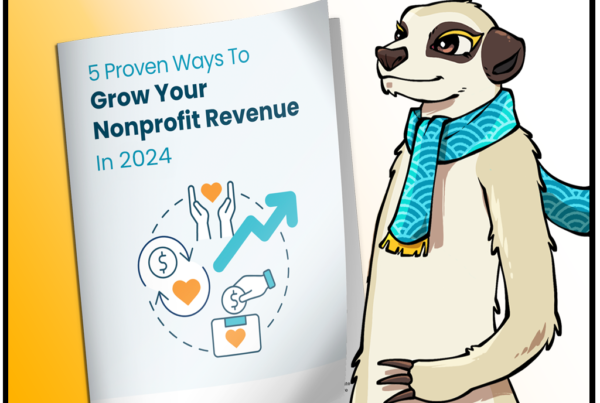Grow your campaign crowd to increase your organization’s awareness and help you reach large digital fundraising goals!
Your fundraising campaign’s success comes from the crowd you bring in, so if you do not quite have the audience you need, you must grow that crowd first!
So where does one get their crowd? This toolkit is for those either newer to this world (with no crowd or too small of a crowd to fund their causes) or for those established fundraisers looking to step up their game and raise a large project goal.
Follow these steps as part of your overall campaign promotional strategy. In our Campaign Promotion Toolkit, we introduced the dual path of campaign pre-launch promotion:
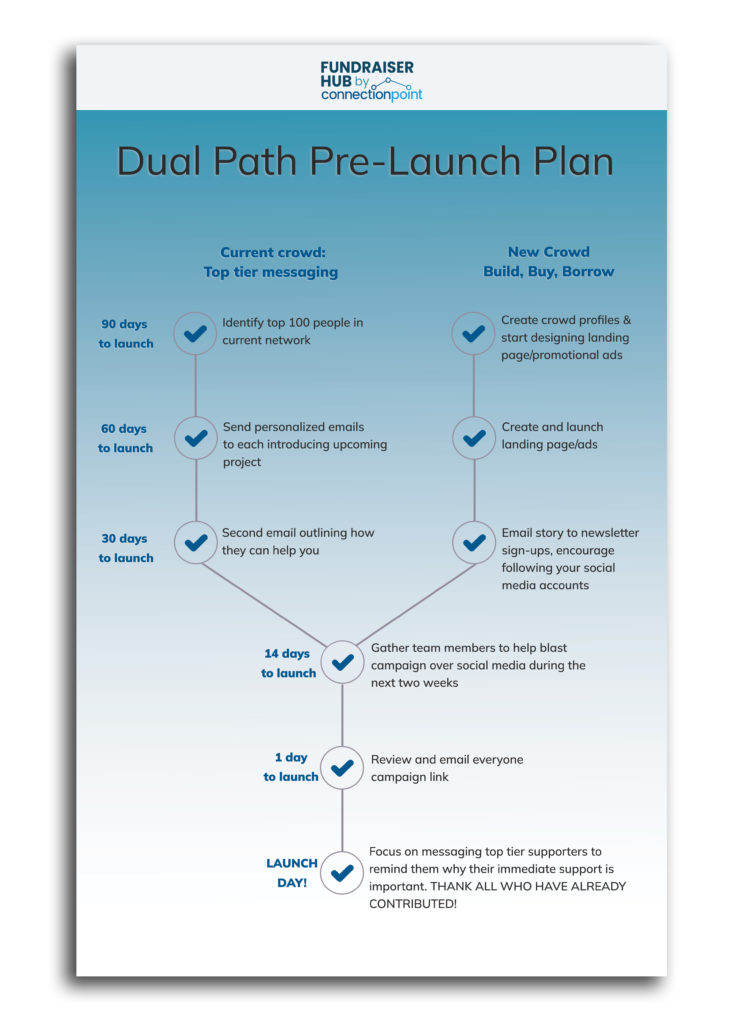
The New Crowd path begins with this toolkit. We’ll go over the step-by-step plan from 90 days to launch to 30 days to launch.
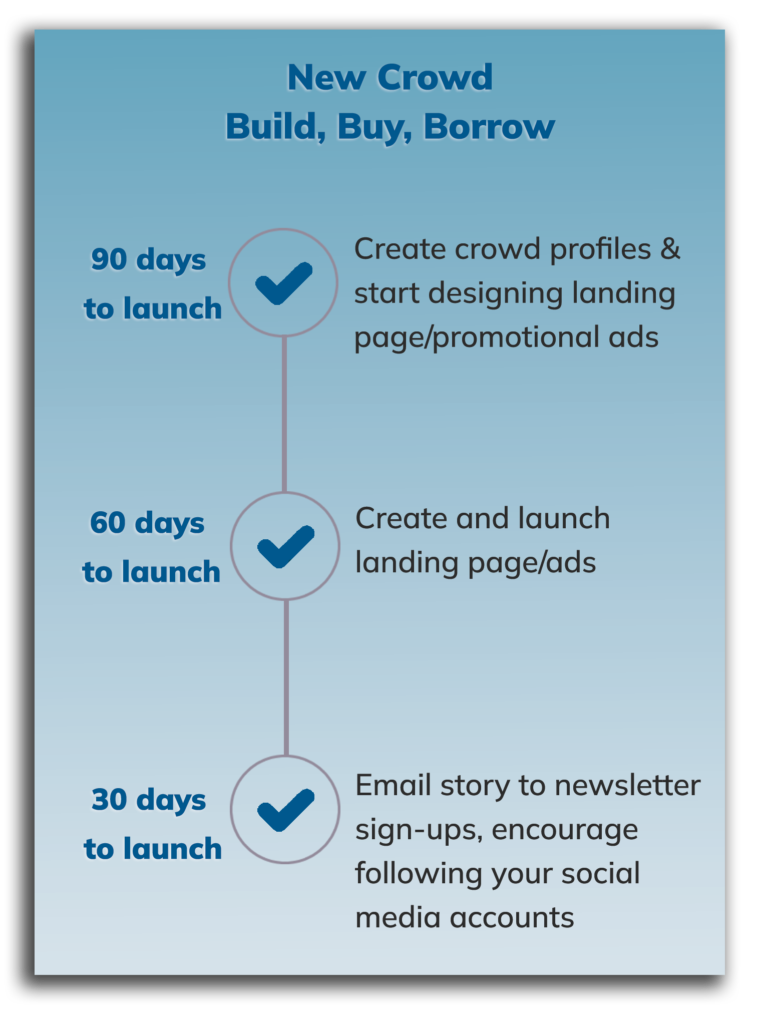
Determine your crowd (90 days before launch)
It’s critical to understand who your crowd is if you’re going to grow it. Simply throwing your campaign out there like a fishing line and hoping you catch something is an ineffective and expensive waste of resources. You need to have the right bait, know where the fish are, and cast your line at the right moment.
This table outlines questions to ask yourself about your ideal crowd.
| WHO is my crowd? | Every cause will have a demographic it’s most likely to connect with, be it residents of a certain area, people who have used your services (or their friends and families), people who have a specific pet or love for a certain animal, plant, or region, etc. Who is yours? |
| WHAT can I discuss with my crowd? | This is the value you bring. Is it insight into tackling the problem you’re trying to solve? Success stories? Does your crowd understand what makes you and your solution(s) impactful? |
| WHERE is my crowd? | You can find your people in multiple places online: social media and their targeted groups, blogs, forums, and, ideally, your own website and social followers. Also consider in-person avenues: flyers on community boards, to your neighbourhood, at trade shows or conferences, or local establishments willing to help. The campaign QR code is perfect here! |
| HOW can I engage my crowd? | Email, newsletters, forum chats, social media posts, blog comments, etc. Get creative here! Can you provide free information, rewards, an event, etc? |
Brainstorm and fill out answers to these questions for your project in the workbook at the bottom of this page.
Grow Your Campaign Crowd Part 1: Create a landing page (60 days before launch)
What is a landing page?
A landing page is a standalone web page designed for one specific purpose. It has a single call-to-action, in this case, for visitors to enter their email addresses onto a mailing list.
Here’s a demo landing page created for a mock animal rescue:
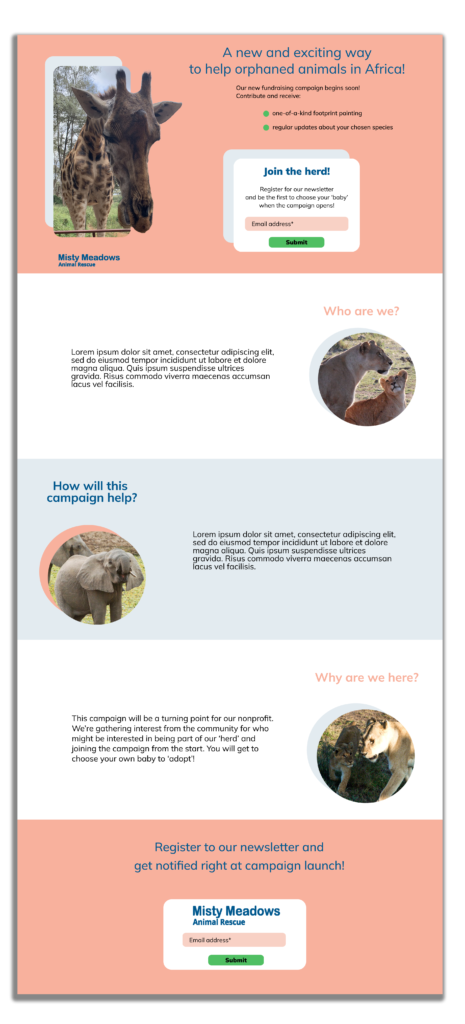
What goes on a landing page?
Someone will land on your landing page because they clicked on an ad: either from your social media pages or a paid ad (see Part 2 of this section). Which means you’ve already grabbed their interest.
Your landing site’s visitors should see everything they need to make the snap decision to enter their email immediately. So, at the top of the page, put in an eye-catching graphic, a short but gripping line describing your value proposition, and a spot to enter and submit their email.
All of this goes ‘before the fold,’ meaning it should fit on the screen without any scrolling. From the example above, this section would be ‘before the fold’:
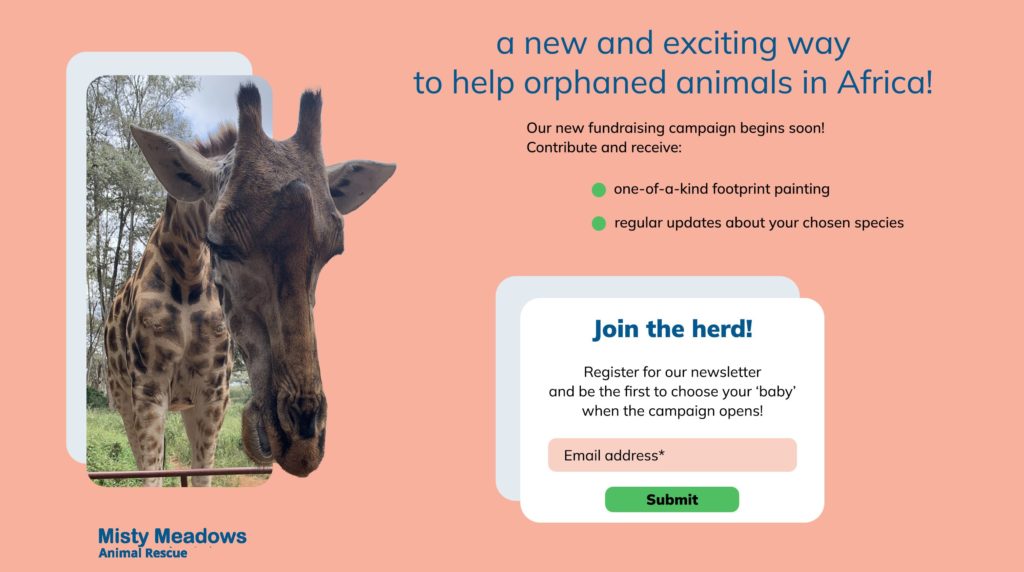
Notice the change in background colour – this separates out the important information. Then if a visitor wants more info, you can include it below (or ‘after the fold’).
You have options for what to put on the rest of your landing page, including (but not limited to):
-
- About you/your organization (Who are we?)
- Short paragraph about the campaign (Why are we here?)
- Target audience (Who will love this?)
- Long-form call to action (What should I do)
- What will happen next, and the approximate timeline
- Any accolades, credentials, etc.
- Links to websites, social media accounts, blogs, etc.
How you format this information is up to you. Just make sure to make it concise and visually appealing.
At the bottom of the page, have another call to action (i.e. the signup link) so someone doesn’t have to scroll and search for it again. These are simple yet important steps to removing the barriers that might stop someone from entering their email. Minds change quickly; we want to grab them as soon as we can!
Use the table in the workbook at the bottom of this page to help plan your landing page.
How do you build a landing page?
Depending on your skill and budget, you have a few options.
-
- Create it on your existing website. You can have a specific page of your website dedicated to signing new visitors up to your newsletter (or guest on a partner’s website).
- Use an email manager with landing page functionality. Some, like Mailchimp, have free versions. Do an internet search for email management and landing pages and find one that works for you.
- Use your campaign! All campaigns on FundRazr, PetFundr, and CoCoPay are viewable before they launch. Then, subscribe to the campaign, and they’ll be notified as soon as you hit GO! (Okay, there’s not actually a button that says ‘go,’ but you get the idea). You would just put the link to the campaign in your ads, and then at the beginning of the story, explain what you’d like them to do.
Any work you do on your campaign in the meantime will be visible, however, which is why you may want to consider an outside website or landing page if anything is meant to be a secret or surprise.
How do people find and get to the landing page?
Through your marketing ads! Onwards to Part 2!
Grow your campaign crowd Part 2: Create your advertisements (60 days before launch)
Now that you have your landing page ready, the next step is to create ads to entice people to visit it.
What is an ad?
An ad is a post with pictures or videos and small amounts of information enticing people to do one thing: click the link to learn more. In this case, the link will be to your landing page or campaign.
IMPORTANT: Ads aren’t limited to your pre-launch plan. Run them after launch as well, so you can continue to build your crowd while the campaign is running, too!
What should go on your ad?
Think about the last time you scrolled through your social media feed or did an internet search. Remember all the ads you see? Do you remember how much time you spent looking at them? Probably one or two seconds, right?
You have one chance to grab your audience’s attention, so make your ad interesting and concise. People should have a solid idea of what your ad is about before they click anything. You want people to click a link to learn more about a future (or current) fundraising campaign, so use a gripping key message to summarize your need and value proposition. Look back to your ‘Defining your audience’ activity – what did you determine about ‘your crowd’ that might make effective ad content?

We highly recommend pulling content from your success stories too!
Ad design differs depending on the media you’re using. For example, with Facebook, you can get away with a picture and more detailed written post, whereas TikTok or Instagram will require a short video to be successful.
Depending on your budget, expertise, and time available, you can use analytics to determine how successful your ads are and then edit them to see what ideas work better than others. Each media platform has analytic capabilities to help you out: Google Analytics, Facebook Pixel or Meta Business Suite, etc. Use them to your advantage!
Where are ads posted?
Let’s go back to our first activity – defining your audience. Where did you determine that ‘your crowd’ hangs out? One social media platform in particular, or many? Any specific groups? What are they generally interested in? This is how you know you’re targeting the right areas because when you create an ad with a social platform, these are the questions you’ll need to know.
We’ll go through this more in-depth in the next parts of this toolkit, but in general, you can utilize paid ads in:
-
- Social media (Facebook, Twitter, LinkedIn, Instagram, TikTok, Reddit)
- Search engines (Google, Bing)
- Video ads (YouTube)
- Partner websites and newsletters
- Influencer profiles
- Ad networks and agencies
Know your budget when making these ads and choosing where they’re posted, and stay within that budget. You can, of course, post for free on your social media accounts, website, newsletters, etc. Even if someone is already signed up for your newsletter, letting them know this campaign is coming increases the likelihood they’ll contribute when it’s launched.
Use the workbook at the bottom of this page to plan your ads and where to post them.
Grow your campaign crowd Part 3: Build, Buy, & Borrow (60 days before launch to throughout your campaign)
We’ve done a lot of work to get to this point, but it’s well worth it. Now, you have new tools to utilize and grow your crowd large enough to support your goals (and beyond, hopefully!).
BUILD – Social media posts
We begin by building from the crowd we already have. Remember, we want to build our email list because these are the people most interested in your campaign. You may have many followers on your social media pages who aren’t enrolled in your email list, and this section is all about grabbing them.
One or two posts on your social media accounts won’t be enough – you want multiple different posts a week to share to grab as much interest as possible. And writing ad-hoc posts, then remembering to do them often enough is time-consuming and not optimal.
We recommend using a social media calendar to schedule your posts. Social media content calendars are valuable tools to help plan your posts across all platforms. It is also more efficient – sit down and spend some time planning your content and where it will be posted for the month, and you will spend less of your day-to-day worrying about it.
In the workbook below, we have an example of a simple social media content calendar, but there are many free options available online if you search for them!
BUY – Paid advertisements
As mentioned above, online ads direct more visitors to your campaign/landing page, ideally resulting in more newsletter registrations (where you’ll announce the campaign launch and share its link). If you have exhausted your ‘Build’ and ‘Borrow’ options in obtaining a crowd, then you may have to look into buying the rest of the crowd you need to hit your target goal.
Social media ads have a ‘price per click’ – meaning you are charged each time someone clicks on your ad. You can set a maximum amount of money to spend, and they’ll pull the ad when the amount of clicks reaches that limit.
In the workbook below, there’s a table to plan your social media ads. You have defined your audience, so you know where they are and what they’re interested in; use that knowledge to plan ads within your budget.
BORROW – Media & Influencers
Not everyone has a budget for buying a crowd! You can, however, borrow someone else’s. From your defined audience, what are some influencers in the field that may help you out? An influencer could be a local celebrity or media network, or internet influencer. Say your cause is rescuing abandoned cats… many people run Instagram accounts for their pets nowadays and have thousands of followers.
Influencers can be:
-
- Media. TV, radio, newspapers, blogs, etc.
- Influencers/celebrities. Sector leaders, associations, local politicians, artists with collaborating interests, etc. (these don’t have to be widely famous celebrities – any local or minor influencer with access to a crowd can be helpful!)
- Online influencers. People with large social media followings (and similar interests to your cause) who may be interested in endorsing your campaign.
In the workbook below is a sheet for you to brainstorm some potential people or groups with crowds to borrow.
And don’t forget – your current crowd will help too!
In addition to everything already covered in this toolkit, a great way to further grow your crowd will be through your crowdfunding!
Crowdfunding is a great way to energize your community to help you spread the news about your project to their community. A well-planned campaign strategy can help you continuously grow your crowd. The ConnectionPoint platforms and this HUB have tools that can help you do that by adding more energy and potential to every step of the cycle.

Build, Buy, & Borrow a Crowd Workbook
*Please consider the environment before printing. Try copying and pasting or recreating tables on your own.*


